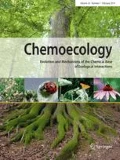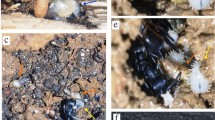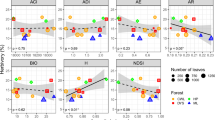Abstract
An underlying assumption of optimal foraging models is that animals are behaviorally, morphologically, and physiologically adapted to maximize their net energy intake. Here we explored whether this concept applies to web-building spiders in a multi-trophic context. If a spider were to build her web next to herbivore-fed-on plants that signal the herbivores’ enemies for help by emitting herbivore-induced plant volatiles (HIPVs), that spider may maximize web captures in the short term. However, she would also risk predation by generalist predators that “listen” to signaling plants to find both herbivore and spider prey, likely resulting in lower overall reproductive fitness for the spider. We tested the hypothesis that HIPVs trigger avoidance responses by web-building spiders. We selected seven common HIPVs and one HIPV elicitor, and in two-choice olfactometer bioassays tested their effect on four synanthropic spider species (false black widow, Steatoda grossa; common cellar spider, Pholcus phalangioides; hobo spider, Eratigena agrestis; western black widow, Latrodectus hesperus). The 8-component HIPV/HIPV elicitor blend had a weak deterrent effect on S. grossa, but the effect did not extend to P. phalangioides, E. agrestis, and L. hesperus. Our findings imply that there was insufficient selection pressure for these spiders to recognize HIPVs in a multi-trophic context, where spiders themselves could become prey if generalist predators or spider-hunting parasitoid wasps were to respond to signaling plants.



Similar content being viewed by others
Data availability
All data are presented in the manuscript.
References
Babikova Z, Gilbert L, Bruce TJA et al (2013) Underground signals carried through common mycelial networks warn neighbouring plants of aphid attack. Ecol Lett 16:835–843. https://doi.org/10.1111/ele.12115
Bellmann H (2010) Der Kosmos Spinnenführer, 1st edn. Kosmos, Stuttgart
Braasch J, Wimp GM, Kaplan I (2012) Testing for phytochemical synergism: arthropod community responses to induced plant volatile blends across crops. J Chem Ecol 38:1264–1275. https://doi.org/10.1007/s10886-012-0202-y
Brechbühl R, Kropf C, Bacher S (2010) Impact of flower-dwelling crab spiders on plant-pollinator mutualisms. Basic Appl Ecol 11:76–82. https://doi.org/10.1016/j.baae.2009.07.001
Calbiague VM, Olivares J, Olivares E, Schmachtenberg O (2017) The Chilean recluse spider (Araneae: Sicariidae) displays behavioral responses to conspecific odors, but not to several general odorants. J Med Entomol 54:1435–1439. https://doi.org/10.1093/jme/tjx101
Chen SY, Feng Z, Yi X (2017) A general introduction to adjustment for multiple comparisons. J Thorac Dis 9:1725–1729. https://doi.org/10.21037/jtd.2017.05.34
Cowie RJ (1977) Optimal foraging in great tits (Parus major). Nature 268:137–139
Dudareva N, Pichersky E, Gershenzon J (2004) Biochemistry of plant volatiles. Plant Physiol 135:1894–1902. https://doi.org/10.1104/pp.104.049981
Dukas R, Morse DH (2003) Crab spiders affect flower visitation by bees. Oikos 101:157–163. https://doi.org/10.1034/j.1600-0706.2003.12143.x
Fischer A (2019) Chemical communication in spiders—a methodological review. J Arachnol 47:1–27. https://doi.org/10.1636/0161-8202-47.1.1
Fischer A, Ayasse M, Andrade MCB (2018) Natural compounds as spider repellents: fact or myth? J Econ Entomol 111:314–318. https://doi.org/10.1093/jee/tox339
Fischer A, Hung E, Gries G (2019) Female false black widow spiders, Steatoda grossa, recognize webs based on physical and chemical cues. Entomol Exp Appl 167:803–810. https://doi.org/10.1111/eea.12825
Foelix R (2015) Biologie der Spinnen, 3rd edn. Chimaira, Frankfurt am Main
Gershenzon J, Dudareva N (2007) The function of terpene natural products in the natural world. Nat Chem Biol 3:408–414. https://doi.org/10.1038/nchembio.2007.5
Gillespie RG, Reimer N (1993) The effect of alien predatory ants (Hymenoptera: Formicidae) on Hawaiian endemic spiders (Araneae: Tetragnathidae). Pacific Sci 47:21–33
Gillung JP, Borkent CJ (2017) Death comes on two wings: a review of dipteran natural enemies of arachnids. J Arachnol 45:1–19. https://doi.org/10.1636/JoA-S-16-085.1
Gols R, Veenemans C, Potting RPJ et al (2012) Variation in the specificity of plant volatiles and their use by a specialist and a generalist parasitoid. Anim Behav 83:1231–1242. https://doi.org/10.1016/j.anbehav.2012.02.015
Heiling AM, Herberstein ME (2004) Predator-prey coevolution: Australian native bees avoid their spider predators. Proc R Soc B Biol Sci 271:196–198. https://doi.org/10.1098/rsbl.2003.0138
Heiling AM, Cheng K, Herberstein ME (2004) Exploitation of floral signals by crab spiders (Thomisus spectabilis, Thomisidae). Behav Ecol 15:321–326. https://doi.org/10.1093/beheco/arh012
Janetos AC (1982) Foraging tactics of two guilds of web-spinning spiders. Behav Ecol Sociobiol 10:19–27
Junker RR, Bretscher S, Dötterl S et al (2011) Phytochemical cues affect hunting-site choices of a nursery web spider (Pisaura mirabilis) but not a crab spider (Misumena vatia). J Arachnol 39:113–117
Krebs JR, Ryan JC, Charnov EL (1974) Hunting by expectation or optimal foraging? A study of patch use by chickadees. Anim Behav 22:953–964. https://doi.org/10.1016/0003-3472(74)90018-9
Maurer B, Hauser A, Froidevaux J-C (1986) ( E)-4,8-Dimethyl-1,3,7-nonatriene and (E, E)-4,8,12-trimethyl-1,3,7,11-tridecatetraene, two unusual hydrocarbonsfrom Cardamon oil. Tetrahedron Lett 27:2111–2112
McCormick AC, Unsicker SB, Gershenzon J (2012) The specificity of herbivore-induced plant volatiles in attracting herbivore enemies. Trends Plant Sci 17:303–310. https://doi.org/10.1016/j.tplants.2012.03.012
Mestre L, Bucher R, Entling MH (2014) Trait-mediated effects between predators: ant chemical cues induce spider dispersal. J Zool 293:119–125. https://doi.org/10.1111/jzo.12127
Naranjo-Guevara N, Peñaflor MFGV, Cabezas-Guerrero MF, Bento JMS (2017) Nocturnal herbivore-induced plant volatiles attract the generalist predatory earwig Doru luteipes Scudder. Naturwissenschaften 104:77. https://doi.org/10.1007/s00114-017-1498-9
Nyffeler M, Birkhofer K (2017) An estimated 400–800 million tons of prey are annually killed by the global spider community. Sci Nat 104:30–42. https://doi.org/10.1007/s00114-017-1440-1
Pekár S (2012) Spiders (Araneae) in the pesticide world: an ecotoxicological review. Pest Manag Sci 68:1438–1446. https://doi.org/10.1002/ps.3397
Pichersky E, Gershenzon J (2002) The formation and function of plant volatiles: perfumes for pollinator attraction and defense. Curr Opin Plant Biol 5:237–243. https://doi.org/10.1016/S1369-5266(02)00251-0
Polis GA, Hurd SD (1995) Extraordinarily high spider densities on islands: flow of energy from the marine to terrestrial food webs and the absence of predation. Proc Natl Acad Sci U S A 92:4382–4386. https://doi.org/10.1073/pnas.92.10.4382
R Core Team (2020) R: A language and environment for statistical computing. R Foundation for Statistical Computing, Vienna
Ruxton GD, Neuhäuser M (2010) When should we use one-tailed hypothesis testing? Methods Ecol Evol 1:114–117. https://doi.org/10.1111/j.2041-210x.2010.00014.x
Schoener TW (1971) Theory of feeding strategies. Annu Rev Ecol Syst 2:369–404
Shafir S, Roughgarden J (1998) Testing predictions of foraging theory for a sit-and-wait forager, Anolis gingivinus. Behav Ecol 9:74–84. https://doi.org/10.1093/beheco/9.1.74
Takács S, Gries G (2001) Communication ecology of webbing clothes moth: attractiveness and characterization of male-produced sonic aggregation signal(s). Can Entomol 133:725–727. https://doi.org/10.1046/j.1439-0418.2003.00724.x
Turlings TCJ, Erb M (2018) Tritrophic interactions mediated by herbivore-induced plant volatiles: mechanisms, ecological relevance, and application potential. Annu Rev Entomol 63:433–452. https://doi.org/10.1146/annurev-ento-020117-043507
Uhl G, Elias D (2011) Communication. In: Herberstein ME (ed) Spider Behaviour. Cambridge University Press, Cambridge, pp 127–189
Unsicker SB, Kunert G, Gershenzon J (2009) Protective perfumes: the role of vegetative volatiles in plant defense against herbivores. Curr Opin Plant Biol 12:479–485. https://doi.org/10.1016/j.pbi.2009.04.001
Valenta K, Nevo O, Martel C, Chapman CA (2017) Plant attractants: integrating insights from pollination and seed dispersal ecology. Evol Ecol 31:249–267. https://doi.org/10.1007/s10682-016-9870-3
War AR, Sharma HC, Paulraj MG et al (2011) Herbivore induced plant volatiles: their role in plant defense for pest management. Plant Signal Behav 6:1973–1978. https://doi.org/10.4161/psb.6.12.18053
Wist TJ, Gries R, Evenden ML (2015) Differential parasitism by a generalist parasitoid is mediated by volatile organic chemicals of the herbivore’s host. Arthropod Plant Interact 9:515–527. https://doi.org/10.1007/s11829-015-9393-9
Witzany G (2006) Plant communication from biosemiotic perspective: differences in abiotic and biotic signal perception determine content arrangement of response behavior. Context determines meaning of meta-, inter- and intraorganismic plant signaling. Plant Signal Behav 1:169–178. https://doi.org/10.4161/psb.1.4.3163
Acknowledgements
We thank Stephen Takács for helpful input and two anonymous reviewers for constructive comments. The research was supported by a Natural Sciences and Engineering Research Council of Canada (NSERC)—Alexander Graham Bell Scholarship to AF and by an NSERC—Industrial Research Chair to GG, with BASF Canada Inc. and Scotts Canada Ltd. as the industrial sponsors.
Funding
The research was supported by a Natural Sciences and Engineering Research Council of Canada (NSERC)—Alexander Graham Bell Scholarship to AF, and by an NSERC—Industrial Research Chair to GG, with BASF Canada Inc. and Scotts Canada Ltd. as the industrial sponsors. The funders had no role in the study design, data collection and analysis, decision to publish, or preparation of the manuscript.
Author information
Authors and Affiliations
Contributions
Conceptualization: AF, GG; data curation: AF, SM; formal analysis: AF, SM; funding acquisition: GG; investigation: SM, RG; methodology: RG, AF; project administration: AF; Resources: GG, RG; supervision: GG; validation and visualization: AF; writing original draft: SM; writing review and editing: GG, AF.
Corresponding author
Ethics declarations
Conflict of interest
All authors state that there is no conflict of interest.
Additional information
Communicated by Günther Raspotnig.
Supplementary Information
Below is the link to the electronic supplementary material.
Rights and permissions
About this article
Cite this article
Fischer, A., MacLennan, S., Gries, R. et al. Herbivore-induced plant volatiles do not affect settling decisions by synanthropic spiders. Chemoecology 31, 201–208 (2021). https://doi.org/10.1007/s00049-021-00340-w
Received:
Accepted:
Published:
Issue Date:
DOI: https://doi.org/10.1007/s00049-021-00340-w




